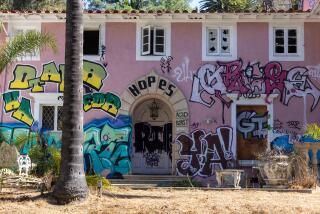A Lone House High Atop Rugged Ridgeline Is Center of Furor
The house that has been erected over the last few months atop the long, rugged ridge separating Glendale from Eagle Rock seems destined to become a structure that will live in infamy.
Workers are just now dressing the wallboard inside and already people who hate the house are demanding that the city of Los Angeles, or Glendale--depending on which side of the ridge they place the blame--buy it for $895,000 and tear it down.
So great is the flap, in fact, that a Los Angeles councilman is at least pretending to take that demand in earnest.
It all reached a peak Monday when about 70 members of The Eagle Rock Assn., commonly known as TERA, showed up outside the house for a demonstration complete with costumed Indians and placard-carrying children.
In a series of speeches, TERA members denounced the house as an abomination against nature and the political process.
“We love Mother Nature the way it was when we found it,” said American Indian Mike Little Deer, who later danced the Eagle and Victory dances under an intermittent drizzle.
Kathleen Aberman, president of TERA, was more concrete.
“We are not going to give up our open space anywhere,” she said, using her placard as an umbrella. “The city will buy this house and tear it down. . . . This is the last betrayal and it will not stand!”
It’s easy enough to see why people are upset. Before the house was built, the mountains north of the Ventura Freeway formed an unbroken, two-mile backdrop of wild-looking terrain for the Eagle Rock valley. Eagle Rock boosters consider the view of those formidable slopes integral with the Rock, itself, in defining their community.
Now, instead of looking at an unblemished ridgeline, they see a lone house whose advantageous height--one instantly comprehends--renders their homes into mere footsteps in a more glorious view, reaching all the way to the sea.
It’s more difficult to assess how the house got there. The story leads through a mire of bureaucratic and legal happenstance.
The owner, Robert Parada, originally tried in the late 1970s to develop several homes on nine acres along the ridge. Although the land lay in both cities, Parada applied to Glendale because the access was through Glenoaks Canyon, whose streets curve up to the north side of the ridge in several places, just far enough away so that no homes can be seen from the other side.
Glendale rejected Parada’s proposal on the grounds that the development would damage the ridge and encroach on the undeveloped side, Zoning Administrator Kathleen Marcus said.
Parada filed a lawsuit. In a settlement, the city worked out an unusual plan to squeeze one large house onto a small plot by excavating to within inches of the ridge while sustaining its precise shape with a high retaining wall.
In defense of a decision made by her predecessor, Marcus said the site “was sensitized to maintain the ridge. The ridge profile is as it used to be.”
There is logic in that, something like the logic of the general who said it was necessary to destroy the village to save it.
All might have been well, even at that, except that the city also allowed a second story with rooms projecting over the ridge and in some cases sitting on top of it.
The people of Eagle Rock, knowing nothing of all this, awoke in shock one day last fall to see 2 by 4s rising on top of their hill.
Their recriminations, of little force in Glendale, are now directed at Los Angeles officials who had a theoretical opportunity to block the construction. Because the house stands partly in Los Angeles, Glendale asked its neighbor to review and approve the plan.
Los Angeles planning and building officials apparently complied with one eye closed, not perceiving in the paperwork the damage that a single house could cause.
In the months the house proceeded from framing to a nearly finished product, TERA’s rage was muted by the Persian Gulf War, one member said Monday. But when the attack came, it dovetailed nicely with the homestretch of an election campaign in which the challengers are picking on Councilman Richard Alatorre as being soft on development.
In an unusually understated comment clearly aimed at Alatorre, TERA is describing the house as a “political-bureaucratic error.”
Alatorre, meanwhile, has protested that he was not informed, introduced motions to protect the rest of the ridgeline and solicited an investigation by the Los Angeles city attorney.
Amazingly, in a letter to TERA last week, Alatorre said he has asked the city staff “to respond to the possible purchase of this property with city funds.”
The people of Eagle Rock have surely been wronged, by both cities. Yet hardly so gravely as the people of either financially strapped city would be if tapped for $1 million to correct the mistake by tearing down a brand-new house. That would be an injustice.
If something must be done, the cities could buy
the house on a 40-year loan, rent it to amortize the note and then see if the will is still there to tear it down.
A mistake in evidence is a more powerful symbol, anyway, than one quickly erased.
More to Read
Sign up for Essential California
The most important California stories and recommendations in your inbox every morning.
You may occasionally receive promotional content from the Los Angeles Times.











